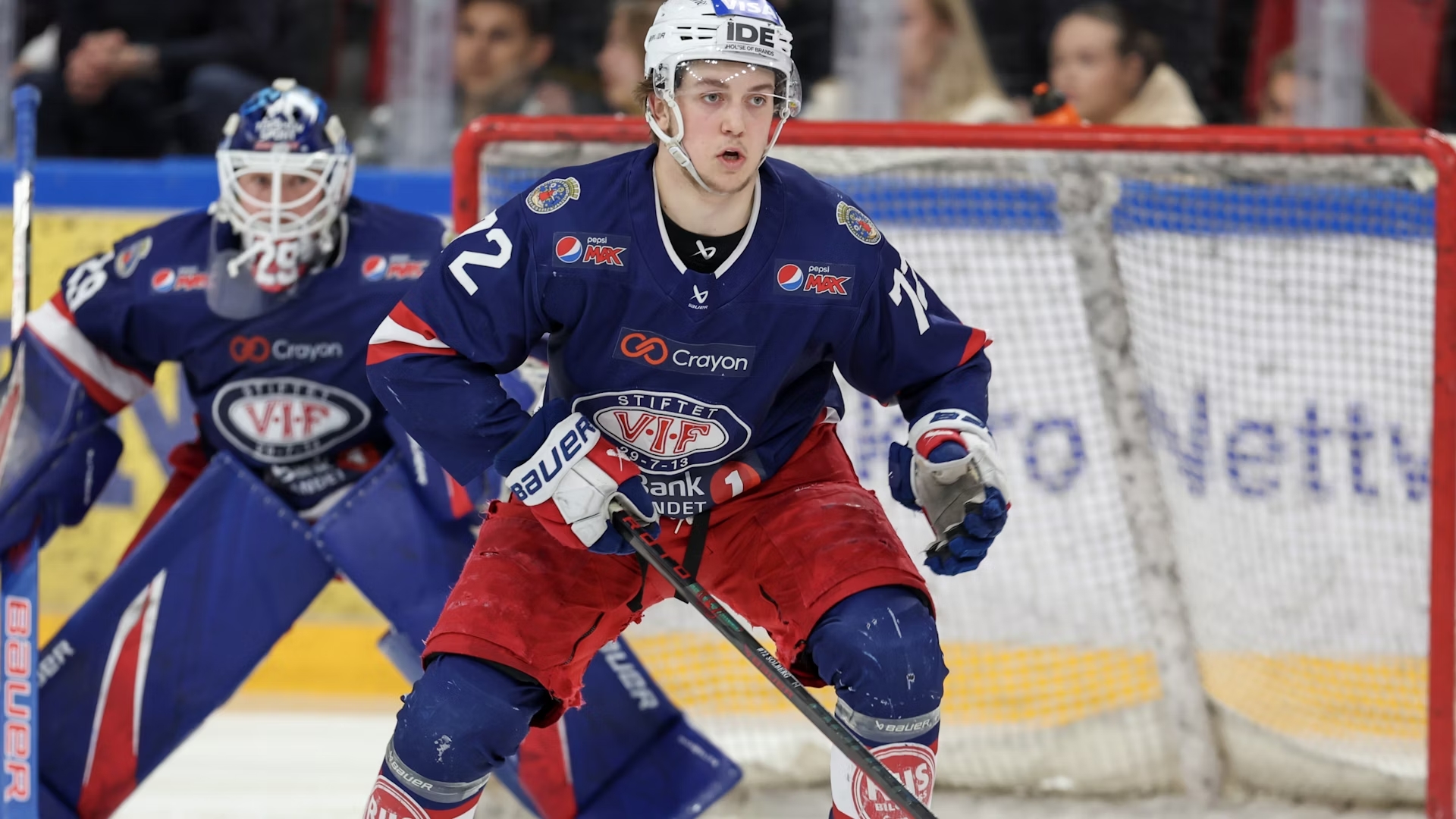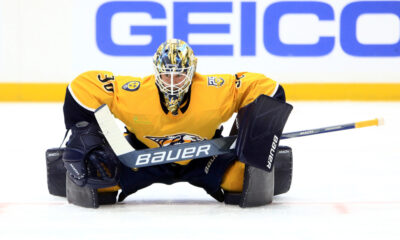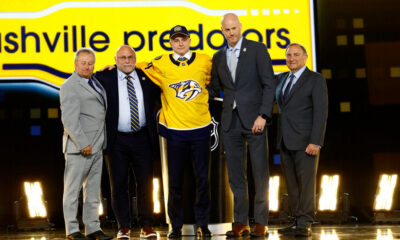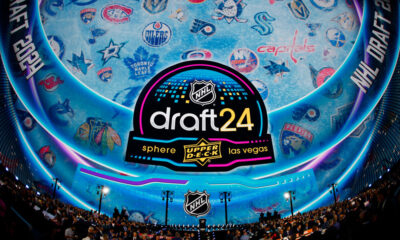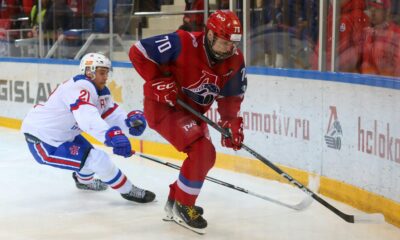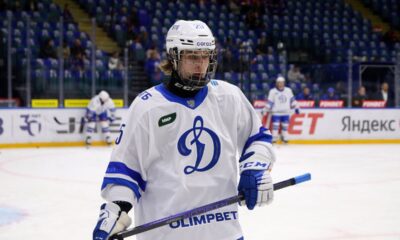The top end of the 2024 NHL Draft class is heavy with defenders. From Canadian juniors to Russia to Norway, several blueliners are jostling to hear their names called on opening night at The Sphere—including the three below.
Carter Yakemchuk | D | Calgary Hitmen (WHL)
After the initial class of five or so defenders that will go in or near the top ten of the NHL Draft, Carter Yakemchuk kicks off the next tier. The right-shot defender stands at 6’3″ and a shade over 200 pounds and is one of the older members of this year’s crop.
Yakemchuk is aggressive, he’s physical, he pops off your screen, and he scored 30 goals to lead WHL defenders this season. He’s hard not to notice on every shift he takes, for better or worse and is incredibly active for a blueliner. In the offensive zone, Yakemchuk drops low from the point often. He exploits vacancies on the weak side and is always ready to pepper the net with shots. He takes a variety of chances, using a very good wrist shot to generate offense, and does so without sacrificing his defensive responsibilities.
In transition, Yakemchuk demands the puck on his stick; he simply wants to be that guy for his team. He’s patient with possession in his end, scanning the ice for his best option. His puckhandling skills are good, but he’s not mistake-free. While his transition success is good, he also works himself into sticky situations occasionally, leaving something to be desired with his distribution skills.
Defensively, Yakemchuk is annoying; he hits everyone and bothers any opponent who crosses in front of his net. While there’s value there, defending his own end is where his game needs the most growth. His positioning doesn’t have a ton of depth to it, and he almost always tries to make the first, flashy play instead of the smartest one. He lunges for an open ice hit or a big poke check without scanning the full play unfolding in front of him. At times, he chases opponents out of the way to lay a hit or he’s just wildly out of position to begin with.
On top of that, Yakemchuk’s skating needs a bit of work. He’s got fine pace at the junior level, but his stride extensions are wider when they should be deeper, he lacks some knee bend, and his upper body lurches forward. Despite that, he’s an electrifying prospect and one who has a serious chance to be a top-pair offensive blueliner for years to come.
Stian Solberg | D | Vålerenga (Norway)
This NHL Draft class holds a lot of promise for Norway’s hockey program, and that includes Stian Solberg. The 6’2″ left-shot defender has grown up in the Vålerenga system and will make the jump to the SHL in Sweden next year.
In 42 games at the pro level in Norway this year, Solberg posted just five goals and 15 points. That total doesn’t wow you, and frankly, there’s not a ton of precedent coming from Norway to compare it to either. But he added a couple of points at the U20 World Junior Championship (WJC) and a few more while starring for his home country at the Men’s World Championship this spring.
While Solberg and Carter Yakemchuk’s offensive profiles may be different, I find them to be somewhat similar defenders. Solberg is just as, if not more, physical; he ties up sticks, boxes out players, and mans the front of his net well, but he isn’t so static that he can’t jump into the rush when his team transitions. He’ll plaster opponents against the wall but almost always make a smart play and dislodge possession. He widens his frame in the defensive zone properly using his stick, arms, and a good base to contain opponents to the perimeter.
His gap control is solid, and he keeps his stick active enough. Sometimes he defaults to going for that first hit, allowing smarter puck carriers to squeeze by or deke across him, but those details should improve with his development.
In transition, Solberg prefers shorter first passes. He likely won’t lead the puck up the ice as much as Yakemchuk, but he’s confident in his decision-making and scans the ice well. He’s a good skater, maintaining proper knee bend, and can move well in all four directions. Despite that, he doesn’t have a noticeable separation gear.
Offense remains the big question mark for the Norwegian defender. He showed more ability at the World Championship and even dazzled with a couple of nifty goals and a nice no-look assist. But he’s likely to play more of a shut-down role at the next level despite good strength behind his slap shot.
Jesse Pulkkinen | D | JYP (Liiga)
If you watched any of the U20 WJC last year, you probably noticed Jesse Pulkkinen; partially because he’s 6’6″ and partially because he was everywhere for Team Finland. Now I’m usually pretty suspicious of overage players, but Pulkkinen’s trajectory this season is fairly rare for a re-entry.
In 2022-23, Pulkkinen played 43 games at the U20 level and notched just four assists. This year, he burst onto the scene with 28 points in 18 U20 games, earning a call-up to the Liiga where he added eight points in 29 games. He also played heavy international minutes for Finland.
The left-shot defender is attractive to teams for a few reasons; his height is the obvious one, but he’s also a mixtape of some of the best puckhandling you’ll see from a blueliner. Pulkkinen could and has dangled around every opponent on the ice; just when you think he’s found himself in a pinch, he’s got another move in his pocket to get out of it. It’s genuinely mesmerizing at times, and most importantly, he keeps his head up while doing it. What’s frustrating is the result isn’t always there. Sometimes he dekes around two opponents and finds a teammate for a beautiful cross-ice pass; other times he dekes around two opponents and then just finds himself needing to dump the puck with no real plan. He’s clever, and he has the frame to protect the puck too, but I have some serious concerns about his decision-making and processing ability.
On top of that, I don’t think Pulkkinen has the speed to explode out of his dekes at higher levels. His skating will always look a bit wonky, but it’s probably a notch below average right now. Defensively, his gaps in transition are fine, and he plays a smart physical game. He’s not immune to puck-watching however, and I think he over relies on teammates to be there when he’s forcing turnovers.
Pulkkinen’s shooting skills are good, and he’s a solid distributor; he’s active in transition much like Yakemchuk and has a truly intriguing presence in the offensive zone. I’m not sold on his game translating to the NHL, but with six picks in the top 100, I wouldn’t mind Nashville taking a shot here.

